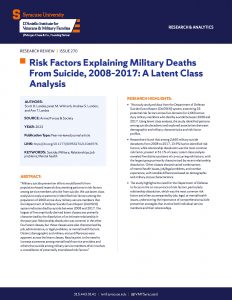ABSTRACT:
“Military suicide prevention efforts would benefit from population-based research documenting patterns in risk factors among service members who die from suicide. We use latent class analysis to analyze patterns in identified risk factors among the population of 2660 active-duty military service members that the Department of Defense Suicide Event Report (DoDSER) system indicates died by suicide between 2008 and 2017. The largest of five empirically derived latent classes was primarily characterized by the dissolution of an intimate relationship in the past year. Relationship dissolution was common in the other four latent classes, but those classes were also characterized by job, administrative, or legal problems, or mental health factors. Distinct demographic and military-status differences were apparent across the latent classes. Results point to the need to increase awareness among mental health service providers and others that suicide among military service members often involves a constellation of potentially interrelated risk factors.”
RESEARCH HIGHLIGHTS:
- This study analyzed data from the Department of Defense Suicide Event Report (DoDSER) system, examining 33 potential risk factors across five domains for 2,660 activeduty military members who died by suicide between 2008 and 2017. Using latent class analysis, the study identified patterns among suicide decedents and explored associations between demographic and military characteristics and risk factor profiles.
- Researchers found that among 2,660 military suicide decedents from 2008 to 2017, 13.9% had no identified risk factors, while relationship dissolution was the most common risk factor, present in 51.1% of cases. Latent class analysis revealed five distinct patterns of co-occurring risk factors, with the largest group primarily characterized by recent relationship dissolution. Other classes showed varied combinations of mental health issues, job/legal problems, and combat experience, with notable differences based on demographic and military status characteristics.
- The study highlights the need for the Department of Defense to focus on the co-occurrence of risk factors, particularly relationship dissolution, which was the most common risk factor and often accompanied by job, legal, or mental health issues, underscoring the importance of comprehensive suicide prevention strategies that involve both individual service members and their relationships.

